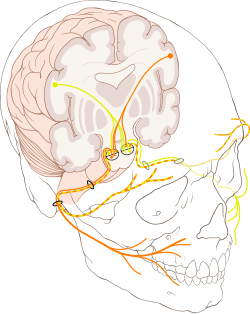Chronic paroxysmal hemicrania
Editor-In-Chief: Prab R Tumpati, MD
Obesity, Sleep & Internal medicine
Founder, WikiMD Wellnesspedia &
W8MD medical weight loss NYC and sleep center NYC
| Chronic paroxysmal hemicrania | |
|---|---|

| |
| Synonyms | N/A |
| Pronounce | N/A |
| Specialty | N/A |
| Symptoms | Severe unilateral headache, lacrimation, rhinorrhea, ptosis, miosis |
| Complications | N/A |
| Onset | Typically in adulthood |
| Duration | 2 to 30 minutes per attack |
| Types | N/A |
| Causes | Unknown, possibly related to trigeminal autonomic cephalalgias |
| Risks | More common in females |
| Diagnosis | Clinical evaluation, response to indomethacin |
| Differential diagnosis | Cluster headache, migraine, SUNCT syndrome |
| Prevention | N/A |
| Treatment | Indomethacin |
| Medication | Indomethacin |
| Prognosis | Good with treatment |
| Frequency | Rare |
| Deaths | None directly attributed |
Chronic paroxysmal hemicrania (CPH) is a rare type of headache disorder that is characterized by frequent, short-lasting attacks of severe unilateral pain. It is classified under trigeminal autonomic cephalalgias, a group of primary headache disorders. The condition is notable for its excellent response to the non-steroidal anti-inflammatory drug indomethacin.
The pathophysiology of CPH is not fully understood, but it is believed to involve the trigeminal nerve and autonomic nervous system. The facial nerve may also play a role, as depicted in the image provided. Diagnosis is primarily clinical, based on the characteristic symptoms and the patient's response to indomethacin. Differential diagnosis includes other headache disorders such as cluster headache and migraine.
CPH is more common in females and typically begins in adulthood. The prognosis is generally good with appropriate treatment, and the condition is considered rare.== Chronic Paroxysmal Hemicrania ==
Chronic Paroxysmal Hemicrania (CPH) is a rare primary headache disorder characterized by frequent, short-lasting, and severe unilateral headaches. It is classified under the group of trigeminal autonomic cephalalgias (TACs), which also includes cluster headaches and SUNCT syndrome.
Clinical Features
CPH is marked by attacks of severe pain that are strictly one-sided, typically around the eye, temple, or forehead. These attacks last from 2 to 30 minutes and can occur more than five times a day. The pain is often accompanied by autonomic symptoms such as conjunctival injection, lacrimation, nasal congestion, or rhinorrhea on the affected side.
Pathophysiology
The exact pathophysiology of CPH is not fully understood, but it is believed to involve dysfunction of the hypothalamus and the trigeminal nerve system. The involvement of the facial nerve (cranial nerve VII) is also considered due to the autonomic symptoms observed during attacks.
Diagnosis
Diagnosis of CPH is primarily clinical, based on the characteristic pattern of headache attacks and response to treatment. It is important to differentiate CPH from other TACs and secondary causes of headache. Neuroimaging may be performed to rule out structural lesions.
Treatment
CPH is uniquely responsive to indomethacin, a nonsteroidal anti-inflammatory drug (NSAID). Indomethacin provides complete relief of symptoms in most patients, which is a key diagnostic criterion. Other treatments, such as verapamil or topiramate, are generally ineffective.
Prognosis
With appropriate treatment, the prognosis for individuals with CPH is excellent. Indomethacin effectively controls the attacks, allowing patients to lead normal lives. However, long-term use of indomethacin may be associated with gastrointestinal side effects, necessitating regular monitoring.
See Also
Transform your life with W8MD's budget GLP-1 injections from $125.
W8MD offers a medical weight loss program to lose weight in Philadelphia. Our physician-supervised medical weight loss provides:
- Most insurances accepted or discounted self-pay rates. We will obtain insurance prior authorizations if needed.
- Generic GLP1 weight loss injections from $125 for the starting dose.
- Also offer prescription weight loss medications including Phentermine, Qsymia, Diethylpropion, Contrave etc.
NYC weight loss doctor appointments
Start your NYC weight loss journey today at our NYC medical weight loss and Philadelphia medical weight loss clinics.
- Call 718-946-5500 to lose weight in NYC or for medical weight loss in Philadelphia 215-676-2334.
- Tags:NYC medical weight loss, Philadelphia lose weight Zepbound NYC, Budget GLP1 weight loss injections, Wegovy Philadelphia, Wegovy NYC, Philadelphia medical weight loss, Brookly weight loss and Wegovy NYC
|
WikiMD's Wellness Encyclopedia |
| Let Food Be Thy Medicine Medicine Thy Food - Hippocrates |
Medical Disclaimer: WikiMD is not a substitute for professional medical advice. The information on WikiMD is provided as an information resource only, may be incorrect, outdated or misleading, and is not to be used or relied on for any diagnostic or treatment purposes. Please consult your health care provider before making any healthcare decisions or for guidance about a specific medical condition. WikiMD expressly disclaims responsibility, and shall have no liability, for any damages, loss, injury, or liability whatsoever suffered as a result of your reliance on the information contained in this site. By visiting this site you agree to the foregoing terms and conditions, which may from time to time be changed or supplemented by WikiMD. If you do not agree to the foregoing terms and conditions, you should not enter or use this site. See full disclaimer.
Credits:Most images are courtesy of Wikimedia commons, and templates, categories Wikipedia, licensed under CC BY SA or similar.
Contributors: Prab R. Tumpati, MD


